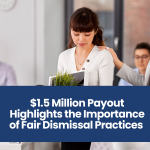In today’s heightened focus on wage compliance, ensuring meticulous oversight of payroll processes is crucial. Accidental underpayments can occur despite best intentions, affecting organisations of all sizes and sectors due to factors ranging from award misinterpretations to simple human errors.
“With the looming criminalisation of wage theft, effective January 2025, distinguishing between inadvertent underpayment and deliberate theft becomes paramount,” explains Michael Byrnes, Partner at law firm Swaab.
Underpayment, he clarifies, doesn’t always equate to theft but can still result in significant civil penalties. To shield your organisation from such pitfalls, here are five common avenues through which underpayments slip through, along with strategies to mitigate these risks.
- Misapplying Awards or Agreements
Misinterpreting which industrial instrument applies can trigger cascading underpayments, affecting everything from hourly rates to leave benefits and superannuation. Byrnes cites a major airline’s case where over $7 million in underpayments stemmed from applying individual contracts instead of the appropriate enterprise agreement.
“Identifying the correct award can be intricate,” Byrnes notes. “Employers might overlook their obligation to apply an award or erroneously assume contractual opt-ins or opt-outs are permissible.”
Regular and thorough training for payroll staff on award application is crucial, reinforcing compliance and mitigating errors.
- Employee Misclassification
Incorrectly categorising roles can also lead to underpayments. Byrnes emphasises that classifications often diverge from job descriptions, complicating compliance.
“To avoid this,” advises Sanam Ahmadzadeh Salmani, Founder at Law Lenz, “employers should rigorously assess role classifications during hiring and periodically review them.”
Implementing checklists and audits can preemptively correct misclassifications, averting future compliance issues.
- Mishandling Overtime and Allowances
Unpaid overtime remains a prevalent issue, exacerbated by ambiguous salary arrangements. Byrnes highlights cases where inadequate premium coverage led to inadvertent underpayments, even among large organisations.
“Accurate record-keeping of hours worked is now imperative,” stresses Byrnes, especially with the rise of flexible work arrangements.
- Overlooking Minimum Engagement Periods
Employers often overlook minimum engagement periods for casual staff, inadvertently underpaying when shifts fall short. Byrnes cites a university case where nearly 60% of underpayments traced back to this oversight.
“Understanding and adhering to minimum engagement provisions is vital,” he advises, urging structured rostering to align with award requirements.
- Managing Long Service Leave
Navigating varying state laws on long service leave poses another compliance challenge. Byrnes underscores the importance of case-specific resolution when discrepancies arise, citing recent cases where oversights led to significant penalties.
“For employers uncertain of their obligations,” he suggests, “referencing the Fair Work Ombudsman’s guidelines can clarify requirements.”
Conclusion
As organisations brace for heightened scrutiny on payroll practices, empowering payroll departments with robust support systems becomes imperative.
“Payroll’s role in classification and award application is critical,” notes Byrnes. “Equipping them with adequate HR support, IT systems, and legal counsel can fortify compliance efforts.”
In conclusion, while accidental underpayments may lack criminal intent, their implications demand proactive prevention measures. By addressing these vulnerabilities head-on, organisations can safeguard against legal, financial, and reputational risks associated with payroll discrepancies.


